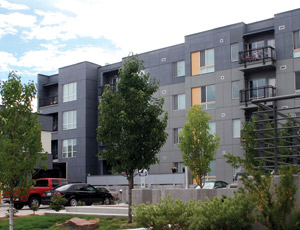The Denver Housing Authority is redefining the image of affordable housing and how to create it.

In order to thrive, people need “vibrant, healthy and sustainable communities,” says DHA Executive Director Ismael Guerrero. For DHA, that means assuming the role of “community builder as much as a housing developer,” he adds.
Joseph Poli, a principal at Denver-based Humphries Poli Architects, which has worked with DHA on several projects, says, “They're not just fulfilling the mission someone else has given them. They're trying to redefine the mission.”
That includes identifying residents as clients and actively engaging them in every project. Residents play a pivotal role in what Guerrero calls an “iterative process” that gathers input through community meetings and helps shape the design. They also provide a construction work force. They are taught life skills, supported with issues like child care and trained in areas like solar panel installation. Solar panels are becoming more common on DHA projects as the authority demands increasing levels of sustainability on its projects.
“Sustainability isn't just lip service, but a truly fundamental professional and philosophical priority for them,” says Scott Conrad, vice president, Milender White Construction Co., Arvada, Colo., the general contractor for DHA's South Lincoln Tower, a $16.5-million public-housing project for low-income seniors. The 100-unit complex represents the first phase of a $250-million, eight-year redevelopment of 17.5 acres in an underdeveloped neighborhood in central Denver.
With completion set for December, the eight-story building is on target to achieve LEED Platinum status. Sustainability features include rooftop photovoltaics, gray-water filtration and reuse, a deep-well geothermal system, geopiers and permeable landscaping features.
Architect Brad Buchanan of Buchanan Yonushewski Group, the Denver firm that designed South Lincoln Tower, calls it “the most sophisticated project I've ever worked on, and I've been doing this for 30 years.” And he says the building is “completely made in the USA. There is not an object in it from elsewhere.”

DHA planned South Lincoln to save residents and itself money in long-term operating costs. “We're making strategic choices based on paybacks,” Guerrero says. Phil Shull, president of Boulder, Colo.-based Deneuve Construction Services, adds, “The residents are obviously not wealthy, so if DHA can do anything to offset the cost of living through sustainable and renewable measures, it will.”
South Lincoln is only a block from a busy light rail stop at 10th and Osage, and again, the goal is to redefine a concept. “We're not creating ‘senior public housing,' but housing for seniors commensurate with market-rate solutions,” says Milender White's Conrad. “When you drive by, you will see 5,000 ft of public art in the exterior skin, a transparent glass link between the two buildings, an outdoor patio space—all beautiful, positive architectural and lifestyle components.”
One of DHA's sustainability initiatives is to do more transit-oriented development (TOD). Guerrero says that housing and transportation account for 50% to 60% of the cost of living for low- to moderate-income families, and TOD, as a means to reduce costs, offers a big step toward self-sufficiency. He adds that the timing of the authority's TOD focus is also a little “self-serving.” DHA has seized TOD opportunities as “a strategy to preserve affordability” in prime urban-infill locations as their market value escalates.
That includes areas in the Regional Transportation District's West Corridor, which runs from downtown Denver to Golden. It is the first of the FasTracks light rail corridors to be constructed and is scheduled for completion in 2013. Guerrero says he hopes intelligent mixed-use development of that area will serve as a model for TOD in the other light rail corridors.
The proximity of South Lincoln to a light rail stop increases the building's public profile. DHA created a department to “aggressively” pursue redevelopment, and South Lincoln is the latest in a string of high-profile neighborhood redevelopments that began with Curtis Park about 10 years ago, Guerrero says.
So far, recent redevelopments alone represent more than $200 million in planned and built projects. Those include the $22-million second phase of South Lincoln, with 270 public-housing and 457 mixed-income units, scheduled to start next year; the 333-unit Sun Valley neighborhood revitalization in west Denver, planned for a late 2011 start; and the 2.8-acre Sustainability Park at 25th & Arapahoe streets in northeast Denver, a demonstration and education center for innovative technologies on healthy communities and sustainable development, also scheduled to start later this year.
Money Matters
During the recession, DHA has used a range of funding options in an approach Guerrero calls “lasagna financing.” In addition to private-sector loans, DHA has leveraged low-income housing tax credits, HOPE VI and stimulus-funded grants, federal programs like HOME and CDBG, various city-funding partnerships and grants, and, increasingly, foundations and grants from partners Guerrero says they've discovered by taking a “more holistic” approach to community revitalization.
Being Flexible
The recession also has forced the agency to take a longer-term view of how and when development can occur. “We can't force the market; we have to create what succeeds today while ensuring it is adaptable for future demands,” Guerrero says.
The DHA has detailed projections for multifamily and commercial developments, but Guerrero says the authority will consider “alternative, interim uses like urban farms and temporary open space” for its vacant land holdings until construction funds are available.
This analytical, pragmatic approach exemplifies what Shull calls DHA's “plowing of the ground. They understand the vagaries of the market, political issues and entrenched attitudes in the neighborhoods.”
That practicality also drives DHA's approach to partnerships. “We're looking for value in the services we're acquiring, but that's not always just the lowest price,” Guerrero says. DHA seeks partners who can “help us push the envelope, who are better than we are and who can teach us,” he adds.
DHA takes seriously its responsibility as a role model for community partnering. “We're committed to sharing lessons learned throughout the industry and beyond it,” Guerrero says. “Our ultimate goal is to create communities of choice—healthy, dynamic, mixed-use developments.”
Article toolbar

Post a comment to this article
Report Abusive Comment